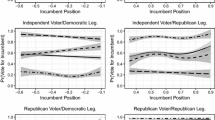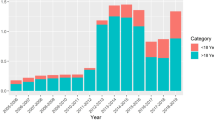Abstract
This paper presents an Exploratory Spatial Data Analysis and Spatial Econometric modeling of the 2011 National Constituent Assembly elections (NCA) in Tunisia. By using electoral data at delegation level of the six main political parties (Ennahda, Congress of the Republic, Ettakatol, the Democratic Progressive Party, the Petition and the Democratie Modernist Pole), we show that geographical proximity matters in Tunisia’s voting behavior. The results overwhelmingly support the spatial Durbin model, including spatially weighted independent variables, as the best model to explain the voting phenomenon. Employing LeSage and Pace’s approach, we find that the largest direct and indirect effects are associated with age cohort and level of educational attainment. Voters who live in poorer neighborhoods are more likely to support the Petition list. Our results also show that younger voters are more likely to vote Ennahda, while older voters with high educational attainment are more likely to support Ettakatol and the Democratie Modernist Pole parties. Men are more likely to support Congress of the Republic than women voters.





Similar content being viewed by others
Notes
National Democratic Institute: Final report on the National Constituent Assembly Elections.
Instance Supérieure Indépendante pour les Elections.
Decree-law 27 (18 April 2011) establishes the ISIE, including its membership and responsibilities (see the electoral law for more details).
AfDB African Development Bank (AfDB) Group, 2012 ‘Tunisia: Economic and Social Challenges Beyond the Revolution’.
INS, “Mesure de la pauvreté et des inégalités en Tunisie 2000–2010 ” (http://www.ins.tn).
Data available on www.isie.tn.
The 2004 census and the 2005 national survey of household consumption are available on www.ins.nat.tn.
By imposing certain restrictions to the SDM model, we can get the SEM and SAR specifications. In particular, if \(\theta = 0\) the SDM reduces to the SAR model. If the restriction \(\theta =-\rho \delta \) is imposed, the SDM is a simplified representation of SEM model.
We use the first-order neighbors matrix for the Moran scatterplot and local Moran’s significance map. Complete results with higher order neighbor weights are available upon request from the authors.
Great Tunis is composed of the following four governorates: Tunis (the capital), Ariana, Ben Arous and Manouba.
Although the OLS results are not included in this paper, they are available from the authors upon request.
Table 4 Model specification tests: spatial error or spatial lag
References
Aghrout, A.: The National Constituent Assembly election in Tunisia, October 2011. Elect. Stud. 34, 294–299 (2014)
Amara, M., Ayadi, M.: The local geographies of welfare in Tunisia: does neighbourhood matter? Int. J. Soc. Welf. 22(1), 90–103 (2013)
Anselin, L.: Spatial Econometrics: Methods and Models, vol. 4. Springer, Berlin (1988)
Anselin, L.: Local indicators of spatial association-LISA. Geogr. Anal. 27(2), 93–115 (1995)
Anselin, L., Bera, A.K., Florax, R., Yoon, M.J.: Simple diagnostic tests for spatial dependence. Reg. Sci. Urban Econ. 26(1), 77–104 (1996)
Anselin, L.: The Moran scatterplot as an ESDA tool to assess local instability in spatial association. In: Fischer, H.S.M., Unwin, D. (eds.) Spatial Analytical Perspectives on GIS, pp. 111–125. Taylor & Francis, London (1996)
Anselin, L., Sridharan, S., Gholston, S.: Using exploratory spatial data analysis to le-verage social indicator databases: the discovery of interesting patterns. Soc. Indic. Res. 82(2), 287–309 (2007)
Ayeb, H.: Social and political geography of the Tunisian revolution: the alfa grass revolution. Rev. Afr. Polit. Econ. 38(129), 467–479 (2011)
Blais, A., Carty, R.K.: Does proportional representation foster voter turnout? Eur. J. Polit. Res. 18, 167–181 (1990)
Blais, A., Aarts, K.: Electoral systems and turnout. Acta Politica 41(2), 180–196 (2006)
Bühlmann, M., Freitag, M.: Individual and contextual determinants of electoral partici-pation. Swiss Polit. Sci. Rev. 12(4), 13–47 (2006)
Cox, K.R.: The voting decision in a spatial context. Prog. Geogr. 1(1), 81–117 (1969)
Cox, G.: Electoral rules and electoral coordination. Annu. Rev. Polit. Sci. 2(1), 145–161 (1999)
Cutts, D., Webber, D.: Voting patterns, party spending and relative location in England and Wales. Reg. Stud. 44(6), 735–760 (2010)
Darmofal, D.: The political geography of macro-level turnout in American political deve-lopment. Polit. Geogr. 25(2), 123–150 (2006)
Elhorst, J.P.: Applied spatial econometrics: raising the bar. Spat. Econ. Anal. 5(1), 9–28 (2010)
Flint, C.: A timespace for electoral geography: economic restructuring, political agency and the rise of the nazi party. Polit. Geogr. 20(3), 301–329 (2001)
Gana, A., Van Hamme, G., Ben Rebah, M.: Géographie électorale et disparités socio-territoriales : les enseignements des élections pour l’assemblée constituante en Tunisie. L’Espace Politique. Revue en ligne de géographie politique et de géopolitique (18) (2012)
Getis, A., Aldstadt, J.: Constructing the spatial weights matrix using a local statistic. Perspect. Spat. Data Anal. 147–163 (2010)
Gimpel, J., Karnes, K., McTague, J., Pearson-Merkowitz, S.: Distance-decay in the poli-tical geography of friends-and-neighbors voting. Polit. Geogr. 27(2), 231–252 (2008)
Grofman, B., Selb, P.: Turnout and the (effective) number of parties at the national and district levels: a puzzle-solving approach. Party polit. 17(1), 93–117 (2011)
Jackman, R.W.: Political institutions and voter turnout in the industrial democracies. Am. Polit. Sci. Rev. 81, 405–423 (1987)
Johnston, R., Pattie, C., Dorling, D., MacAllister, I., Tunstall, H., Rossiter, D.: Local context, retrospective economic evaluations, and voting: the 1997 general election in England and Wales. Polit. Behav. 22(2), 121–143 (2000)
Johnston, R., Jones, K., Sarker, R., Propper, C., Burgess, S., Bolster, A.: Party support and the neighbourhood effect: spatial polarisation of the British electorate, 1991–2001. Polit. Geogr. 23(4), 367–402 (2004)
Johnston, R.J., Propper, C., Burgess, S., Sarker, R., Bolster, A., Jones, K.: Spatial scale and the neighbourhood effect: multinomial models of voting at two recent British general elections. Br. J. Polit. Sci. 35(3), 487–514 (2005)
Kim, J., Elliott, E., Wang, D.: A spatial analysis of county-level outcomes in US presi-dential elections: 1988–2000. Elect. Stud. 22(4), 741–761 (2003)
Knight, K., Marsh, M.: Varieties of election studies. Elect. Stud. 21(2), 169–187 (2002)
Korotayev, A., Zinkina, J.V.: Egyptian revolution: a demographic structural analysis. Entelequia: revista interdisciplinar (13), 139–169 (2011)
LaGraffe, D.: The youth bulge in Egypt: an intersection of demographics, security, and the Arab Spring. J. Strat. Secur. 5(2), 65–80 (2012)
Leigh, A.: Economic voting and electoral behavior: how do individual, local, and national factors affect the partisan choice? Econ. Polit. 17(2), 265–296 (2005)
LeSage, J., Pace, R.K.: Introduction to Spatial Econometrics, vol. 196. Chapman & Hall/CRC, Boca Raton (2009)
Mabrouk, M.: A revolution for dignity and freedom: preliminary observations on the social and cultural background to the Tunisian revolution. J. North Afr. Stud. 16(4), 625–635 (2011)
Mészáros, J., Solymosi, N., Speiser, F.: Spatial distribution of political parties in Hungary 1990–2006. Polit. Geogr. 26(7), 804–823 (2007)
Milligan, K., Moretti, E., Oreopoulos, P.: Does education improve citizenship? Evidence from the United States and the United Kingdom. J. Public Econ. 88(9), 1667–1695 (2004)
Moran, P.A.P.: The interpretation of statistical maps. J. Royal Stat. Soc. B 10, 243–251 (1948)
Moran, P.A.P.: A test for serial correlation of residuals. Biometrica 37, 178–181 (1950)
Pattie, C., Johnston, R.: ‘People who talk together vote together’: an exploration of contextual effects in Great Britain. Ann. Assoc. Am. Geogr. 90(1), 41–66 (2004)
Pelkonen, P.: Length of compulsory education and voter turnout-evidence from a staged reform. Public Choice 150(1–2), 51–75 (2012)
Reith, N.: Tunisia’s Jasmine revolution: A geo-spatial demographic analysis of protest, vio-lence, and voting patterns. Extended Abstract (Population Association of America, 2013 Annual Meeting Program) (2013)
Sauerzopf, R., Swanstrom, T.: The urban electorate in presidential elections, 1920–1996. Urban Aff. Rev. 35(1), 72–91 (1999)
Shin, M., Agnew, J.: The geographical dynamics of Italian electoral change, 1987–2001. Elect. Stud. 26(2), 287–302 (2007)
Tapiador, F., Mezo, J.: Vote evolution in Spain, 1977–2007: a spatial analysis at the municipal scale. Polit. Geogr. 28(5), 319–328 (2009)
Unwin, A., Unwin, D.: Spatial data analysis with local statistics. J. Royal Stat. Soc. 47(3), 415–421 (1998)
Van Egmond, M., De Graaf, N.D., Van Der Eijk, C.: Electoral participation in The Netherlands: individual and contextual influences’. Eur. J. Polit. Res. 34(2), 281–300 (1998)
Vilalta, C.: The local context and the spatial diffusion of multiparty competition in urban Mexico, 1994–2000. Polit. Geogr. 23(4), 403–423 (2004)
Author information
Authors and Affiliations
Corresponding author
Additional information
This paper is dedicated to the people of Tunisia, and to those who gave their lives for dignity and freedom.
Rights and permissions
About this article
Cite this article
Amara, M., El Lahga, A. Tunisian constituent assembly elections: how does spatial proximity matter?. Qual Quant 50, 65–88 (2016). https://doi.org/10.1007/s11135-014-0137-1
Published:
Issue Date:
DOI: https://doi.org/10.1007/s11135-014-0137-1






